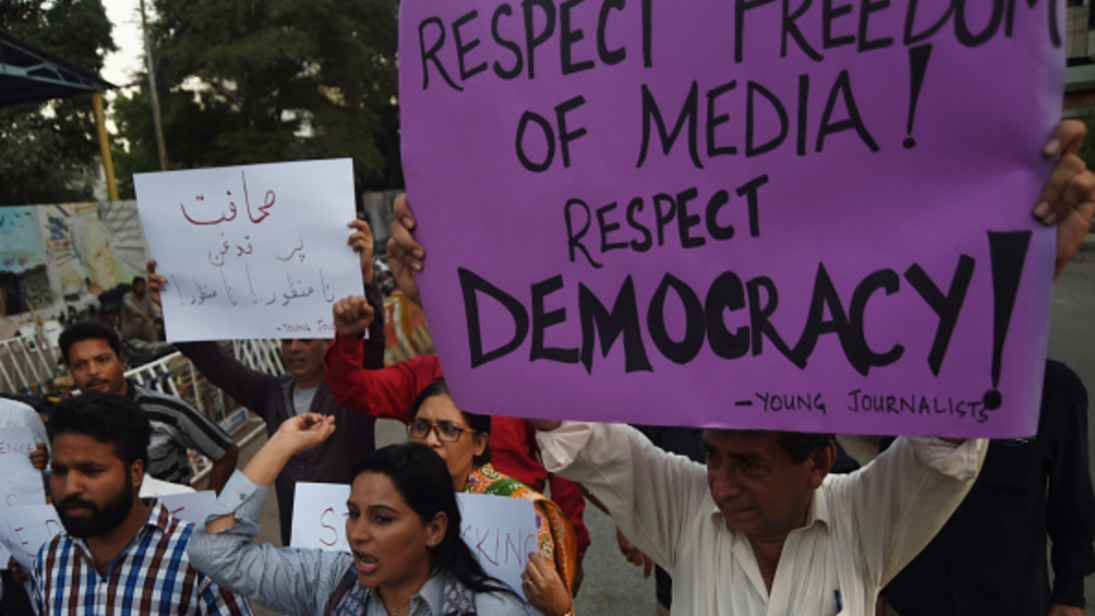
Press freedom in Pakistan is under increasing threat. In May 2021, a proposed ordinance to develop a centralized media regulatory authority, named Pakistan Media Development Authority (PMDA), made rounds on social media. Human rights activists and journalists in Pakistan created an uproar, calling PMDA a draconian institution. Opposition parties in Pakistan criticized the Pakistan Tehreek-e-Insaaf (PTI)-led government for suggesting establishing PMDA through an executive ordinance instead of discussing and voting on it in the parliament. While the authenticity of the document is undetermined — Information Minister Fawad Chaudhary claimed it was fake — it was confirmed that the government planned to replace all individual media regulatory bodies with one centralized authority that regulates print, electronic, and digital media together.
While the state maintains that it seeks to avoid bureaucratic red tape and reduce regulation costs by converging the “fractured” media regulatory system in Pakistan, there are two main problems in the current draft of the PMDA ordinance. First, it includes several proposals antithetical to the democratic norms of freedom of the press. Second, while the proposed authority intends to regulate digital and social media more austerely, the proposal does not answer technical questions on how this could be achieved. To sufficiently address these two concerns, the government should present this bill to the parliament. Discussion in the parliament is not only important to satisfy democratic norms but also essential to achieve a balance between the needs of the government for better media regulation and the demands of the opposition for improved freedom of the press. It also brings more transparency to the discussion on the technical and normative issues surrounding centralized regulation.
The Potential Threat to Democracy
Several civil society activists and media bodies are concerned about the potential implications of the proposed—and quite stringent—ordinance on the democratic health of the country. For instance, the ordinance requires all media outlets—print, electronic, and digital—to obtain a government license on an annual basis to remain operational. Non-adherence to the code of conduct—which it is yet to be drafted by PMDA—could result in severe consequences including three to five years of imprisonment and fines worth millions of rupees. PMDA could also suspend a media outlet, summon the content producer for an explanation, and penalize media channels without warning or offering an opportunity for a hearing. The ordinance suggests forming media complaint councils that would hear public complaints against the media. The decisions of the councils and the authority can only be challenged before a media tribunal that oversees issues related to professional problems of media personnel. Furthermore, the only way to challenge the decision of the tribunal is through the Supreme Court of Pakistan.
As the proposed ordinance prohibits any content defaming “the Head of State, or members of the armed forces, or legislative or judicial organs of the state,” local journalists believe this is a continuation of the government’s attempt to build a censorship regime.
The government claims that the ordinance aims to empower journalists, allowing them to file complaints against media houses about salary cuts or non-payment. The Information Minister Fawad Chaudhry also clarified that the draft circulating on social media is only a concept paper shared with media outlets to have their feedback and inclusion of relevant stakeholders is necessary. Yet all major journalist associations view the ordinance with much skepticism, calling the proposed draft “media martial law.”
For the last few years, Pakistan’s rank in the global freedom of press index has constantly declined, owing to growing cases of abduction and assault on journalists. Recent high-profile cases—such as the abduction of Matiullah Jan in July 2020, the attack on Absar Alam in April 2021, and the assault of Asad Ali Toor in his house—resulted in harsh international censure. Global human rights organizations such as Human Rights Watch and Amnesty International shared concerns regarding worsening freedom of the press in Pakistan. As all three journalists were strongly critical of the government, the journalist community alleged that these attacks are an effort by the state to intimidate dissenters. The suspension of renowned journalist Hamid Mir by Geo News Network after his scathing criticism against the political establishment further strengthened the media’s mistrust of the government. As the proposed ordinance prohibits any content defaming “the Head of State, or members of the armed forces, or legislative or judicial organs of the state,” local journalists believe this is a continuation of the government’s attempt to build a censorship regime. As the plan for such a regulatory authority is still in the works, the government must address these concerns to avoid any further damage to Pakistan’s global democratic standing.

Technical Concerns
The current regulatory mechanism in Pakistan is composed of several bodies and directives, mainly including print and electronic media regulation. Pakistan Electronic Media Regulatory Authority (PEMRA), established through a presidential ordinance in 2002, regulates private electronic media. Press Council of Pakistan, the Audit Bureau of Circulation (ABC), and the press registrar regulate the print media. In contrast, digital media regulation is limited to cybercrime laws implemented by the Federal Investigation Authority (FIA). While PEMRA control over electronic media is harshening, print and digital media in Pakistan remain relatively free. The PMDA ordinance proposes merging different forms of media under one PEMRA-like authority to extend government control over print and digital media.
However, merging regulation bodies poses technical challenges as each form of media has different operating dynamics that require custom directives. Considering online news media networks can target narrow audiences, and there is a lack of user control over content received, regulation of social media is a complicated process. European examples of successful laws regulating social media would not work in Pakistan, considering its digital industry is not large enough to entice social media giants into accepting government rules. Recent FIA efforts to coordinate with social media corporations such as Facebook and Twitter to address cybercrime complaints failed as social media platforms did not respond to FIA requests.
Considering qualification of the ordinance through an executive order is antithetical to democratic norms and is bound to generate severe resistance from media houses and opposition parties, the government should discuss the proposal in the parliament.
The methods proposed in the ordinance, such as creating a licensing system for digital media platforms, are only limited to official digital accounts of media organizations and verified accounts of media persons and does not apply to private social media accounts Even if the government bans some digital accounts for violating rules, it is quite simple to create a new profile on the same social media platform. Hence, a major complaint of Pakistan regarding disinformation through Indian accounts would remain unaddressed through this ordinance. More importantly, while some governments have established information filters for content regulation and search engine monitoring systems to keep an eye on citizens’ online activity, such complex and sophisticated solutions require substantial economic investments. This raises difficult questions regarding resource allocation capabilities in financially strained Pakistan.
Conclusion
While the PTI government believes the proposed media regulatory ordinance could improve the media regulatory structure in Pakistan, civil society views it as an attempt to suppress the media. In order to address criticism of the PMDA ordinance, the Ministry of Information and Broadcasting has constituted a committee to liaise with relevant stakeholders. Considering qualification of the ordinance through an executive order is antithetical to democratic norms and is bound to generate severe resistance from media houses and opposition parties, the government should discuss the proposal in the parliament.
While disinformation and harmful content on social media remain key concerns globally, there are no easy methods to regulate cyberspace. Regulating digital content and finding a consensus on regulatory standards that avoid violating constitutional freedoms is a complex undertaking. The PTI government must adopt a cautious and inclusive approach while revising media regulatory laws. In addition to the media houses, the government must also consult independent journalist bodies, civil rights groups, and opposition parties to ensure that the revised regulation mechanisms do not threaten freedom of media and expression.
***
Image 1: AFP via Getty Images
Image 2: FAROOQ NAEEM/AFP via Getty Images


